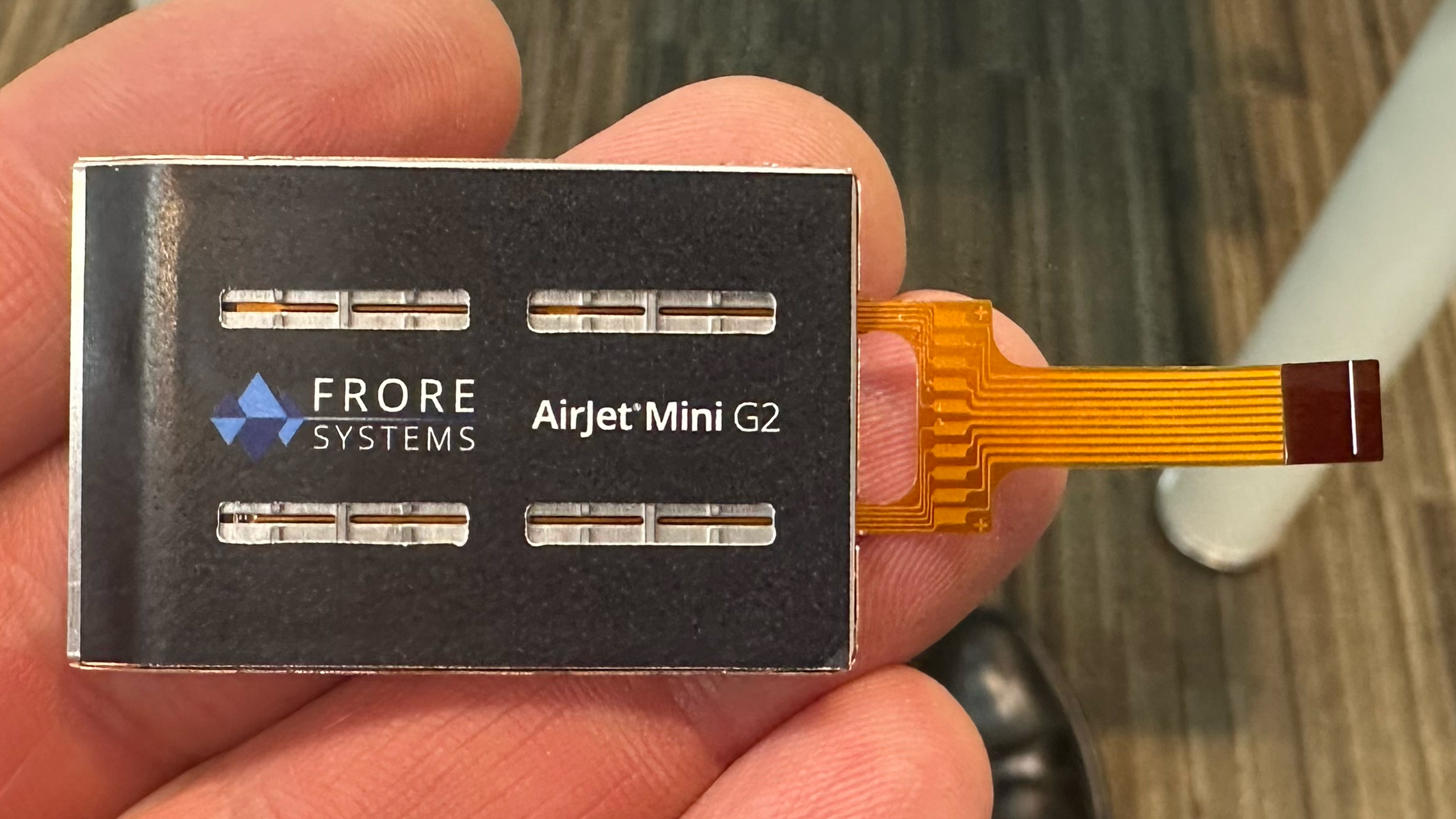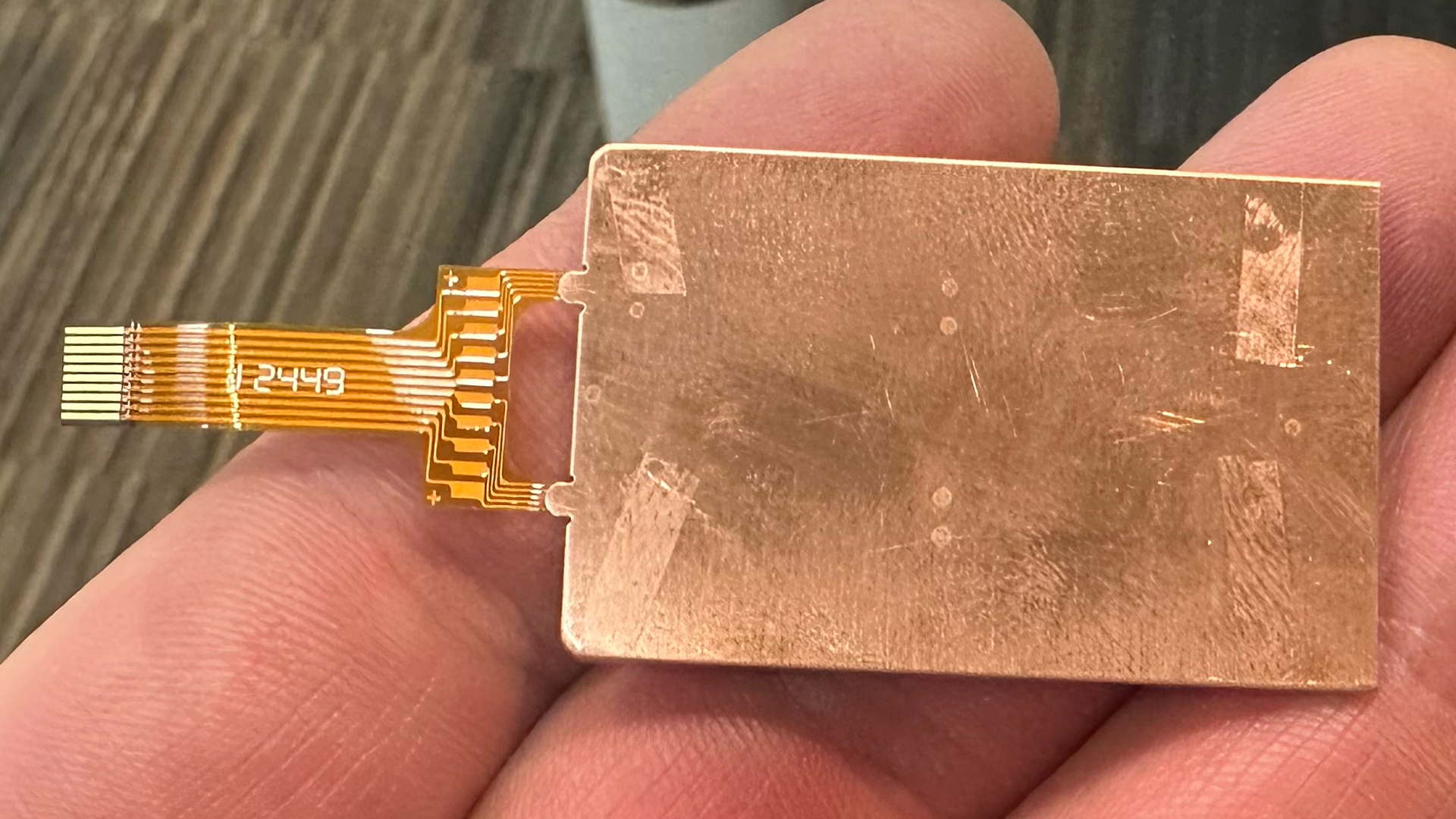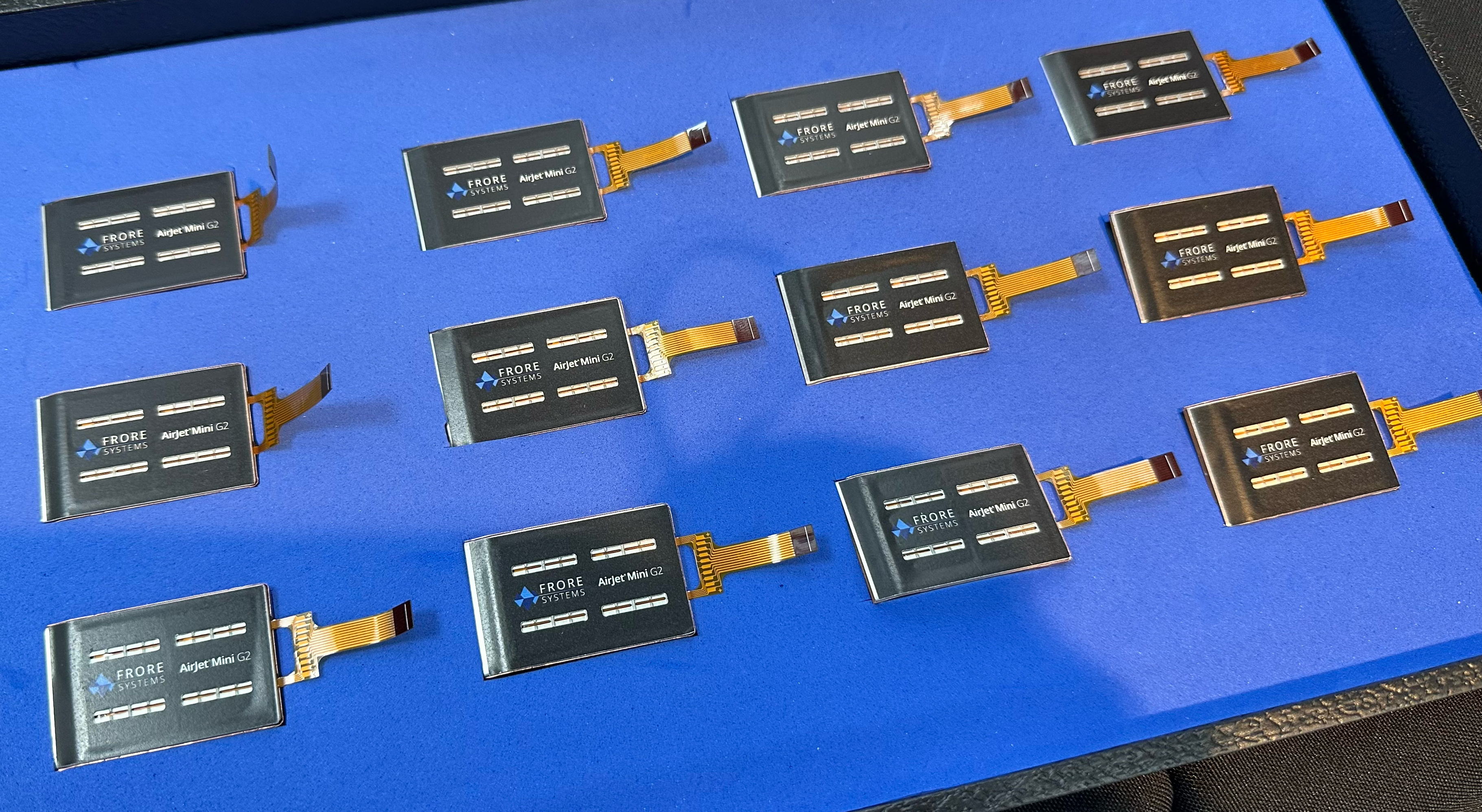Fanless AirJet Mini G2 cooler promises 42% more cooling performance in the same form-factor

Frore Systems has unveiled its 2nd Generation AirJet Mini solid-state active cooling device that offers a 50% higher cooling performance while maintaining the same form-factor. The new model, which was demonstrated at Computex, will open new doors for Frore’s Airjet technology, as many devices nowadays require more cooling performance than the original AirJet Mini could provide. The AirJet boasts significant advantages over conventional cooling because it doesn't use a fan to move air, boosting performance and improving reliability.
The new AirJet Mini G2 can remove up to 7.5W of heat at 85 degrees Celsius die temperature and at 25 degrees Celsius ambient temperature while generating 1750 Pascals of back pressure at a silent 21 dBA noise level while maintaining 27.3mm × 41.6mm × 2.5mm dimensions and reducing weight to 7 grams. Frore’s original AirJect Mini could dissipate up to 5.25W in the same conditions, thus, the new one provides over 42% higher performance.


Since the new unit generates the same back pressure and therefore consumes around the same amount of power as its predecessor, its higher performance has been achieved primarily by internal optimizations, though exact details are not published for now. In any case, the performance increase indicates that Frore continues to refine its technology, so it is reasonable to expect the company to eventually offer even higher performance solutions for different classes of applications.
Just like the original solid-state active cooling device, the new AirJet Mini G2 is dustproof (it can clean itself automatically) and water resistant. It is also scalable, meaning that several AirJet Mini G2 chips can be used to cool down devices that dissipate more than 7.5W. In fact, four of such devices can remove 30W of heat, which is the heat dissipation of CPUs inside low-power laptops. More chips can potentially cool down even more power-hungry devices.
The first device to incorporate Frore’s AirJet Mini G2 cooling chip is an industrial machine vision camera developed by Crevis, a South Korean manufacturer specializing in industrial imaging solutions. This integration addresses the thermal challenges associated with high-performance imaging and enables better image quality and higher frame rates while maintaining a compact design.
However, Frore’s customers are expected to use G2 chips across the board for a wide range of applications, including PCs, Wi-Fi hot spots, industrial system-on-modules, and SSDs. At the show, the company implied that Iodyne, a maker of SSDs, will upgrade its portable SSD with AirJet Mini G2 to further lower temperatures.
Follow Tom's Hardware on Google News to get our up-to-date news, analysis, and reviews in your feeds. Make sure to click the Follow button.
Get Tom's Hardware's best news and in-depth reviews, straight to your inbox.

Anton Shilov is a contributing writer at Tom’s Hardware. Over the past couple of decades, he has covered everything from CPUs and GPUs to supercomputers and from modern process technologies and latest fab tools to high-tech industry trends.
-
thestryker I'm not sure their efficiency is quite there for battery powered devices yet, but they're getting close. Since we're stuck with M.2 for desktop systems I could see one of these being about perfect now though. While it wouldn't be enough for gen1 PCIe 5.0 controllers it's plenty for the new node shrunk ones. If a cooler could be designed so the airjet exhaust went over fins for cooling NAND the airjet wouldn't have to be connected to it.Reply
Looking forward to seeing them keep advancing the technology because it seems so good for low noise/industrial type application. -
bit_user Reply
I disagree. First, you should consider that existing solutions already involve some kind of active cooling (i.e. which use power). Second, it only needs to run at max speed when the SSD is under high load, which should be a minority of the time.thestryker said:I'm not sure their efficiency is quite there for battery powered devices yet, but they're getting close.
I think it would add too much cost for most SSDs. Also, you'd only need it in cases like where a SSD was stuffed under a dGPU. In most M.2 slots, there's enough headroom for a bulky heatsink that's adequate when the case has some reasonable airflow.thestryker said:Since we're stuck with M.2 for desktop systems I could see one of these being about perfect now though.
But you might lose efficiency, that way. Also, the NAND is what's most temperature-sensitive. IMO, it would make more sense to attach the cooler to the NAND and have its exhaust flow through a heatsink attached to the controller.thestryker said:If a cooler could be designed so the airjet exhaust went over fins for cooling NAND the airjet wouldn't have to be connected to it. -
thestryker Reply
When the controller makes up the vast majority of the power consumption it really doesn't make sense to attach it to the NAND. If you were only worried about the NAND there would be no point in using one of these at all.bit_user said:But you might lose efficiency, that way. Also, the NAND is what's most temperature-sensitive. IMO, it would make more sense to attach the cooler to the NAND and have its exhaust flow through a heatsink attached to the controller.
While I certainly agree about the cost the drives most likely to need cooling (PCIe 5.0) are also the ones that are usually going to be interfered with by modern video cards. My video card is small at ~2.5 slots (comparatively speaking) and it still covers up two M.2 slots and the top one is close enough a large heatsink might not fit due to the back plate.bit_user said:I think it would add too much cost for most SSDs. Also, you'd only need it in cases like where a SSD was stuffed under a dGPU. In most M.2 slots, there's enough headroom for a bulky heatsink that's adequate when the case has some reasonable airflow.
So again while it wouldn't make financial sense it would be perfect for the job. I wouldn't be surprised if the only place we saw them with SSDs is expensive external enclosures.
Nobody actively cools SSDs in battery powered devices. I was referring to replacing fans with these. Though that does bring up a good point as fans do have a small amount of ancillary airflow which these do not which means they don't help cool anything not attached to the heatsink.bit_user said:I disagree. First, you should consider that existing solutions already involve some kind of active cooling (i.e. which use power). Second, it only needs to run at max speed when the SSD is under high load, which should be a minority of the time.
Anyways back to the point: handhelds tend to use fans that max out at 2.5W (typically I'd expect less than 100% fan speed, but that depends entirely on the cooling system). Steam Deck is up to 15W (1 fan) and ROG Ally up to 30W (2 fans) and keep in mind this doesn't include memory/platform power. To replace the fans and keep the same maximum TDP it would take 3 (3W) or 5 (5W) of the new airjets (could maybe get away with 2/4, but I'm not certain if the airjet ratings are hard limits as the only retail compute product using first gen was TDP locked below maximum airjet rating). While I think the heatsink design could be less complex I doubt there would be any material savings since they all have to be connected.
I would be surprised if a single airjet was anywhere near as cheap as a fan, twice as many are needed minimum and wouldn't gain anything power efficiency or performance wise. The gains by using them would be purely customer focused as the hardware itself would probably run less hot and be less noisy. I would certainly pay more for that, but I'm not sure how many people would for a mass market type product. -
bit_user Reply
The NAND is the most temperature-sensitive component on a SSD. A controller can probably tolerate close to 100 C, while NAND (IIRC) shouldn't get above ~70 C.thestryker said:When the controller makes up the vast majority of the power consumption it really doesn't make sense to attach it to the NAND. If you were only worried about the NAND there would be no point in using one of these at all.
It's like why we don't tend to have active cooling of MOSFETs on motherboards, even though they're easily the hottest thing on the board. You don't focus on cooling the hottest thing, you focus on cooling the thing that's most temperature-sensitive.
But how many of the occluded slots are PCIe 5.0-capable?thestryker said:the drives most likely to need cooling (PCIe 5.0) are also the ones that are usually going to be interfered with by modern video cards. My video card is small at ~2.5 slots (comparatively speaking) and it still covers up two M.2 slots and the top one is close enough a large heatsink might not fit due to the back plate. -
thestryker Reply
Definitely above that for NAND, but I have no idea what the threshold really is since every SSD manufacturer seems to have arbitrary limits. A lot of SSD manufacturers don't expose multiple temperature sensors, but based on those that do a maximum in the low-mid 80s seems likely.bit_user said:The NAND is the most temperature-sensitive component on a SSD. A controller can probably tolerate close to 100 C, while NAND (IIRC) shouldn't get above ~70 C.
It's not about what runs hottest it's about what outputs the most heat. If the controller is making up the majority of the power consumption that's the important part to isolate. The NAND isn't what's soaking SSD heatsinks it's the controller (on high performance drives). I would love to see the split on the newest drives, but Samsung's sensors apparently both read the same and I haven't seen numbers on the new SanDisk (working on the assumption that if the temperatures are close to the same with a heatsink that the power consumption is as well).bit_user said:It's like why we don't tend to have active cooling of MOSFETs on motherboards, even though they're easily the hottest thing on the board. You don't focus on cooling the hottest thing, you focus on cooling the thing that's most temperature-sensitive.
It's never going to be more than 2 on client systems, and on the workstation side varies sometimes significantly by board design.bit_user said:But how many of the occluded slots are PCIe 5.0-capable?
